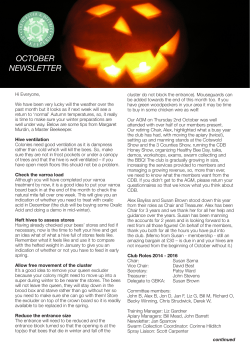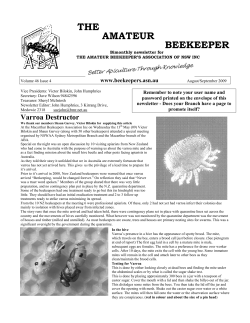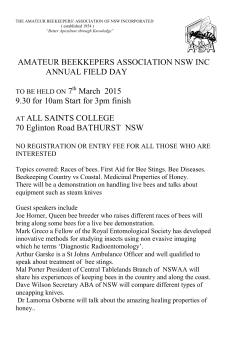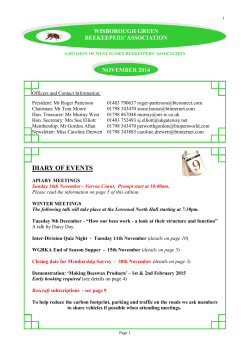
April 20, 2015 - North Okanagan Beekeepers
North Okanagan Beekeepers Monthly Meeting MINUTES April 20, 2015 7:00-9:00 Attendance: 1. 39 Welcome a) New members b) Email list c) A handout regarding the club was distributed. 2. 50/50 Total value of 50/50 collected: $ 66 Winner of $33 drawn: Doug Sader 3. Review of minutes a) Adoption of Minutes from March 16, 2015. Moved, seconded, carried. 4. Old Business a) Thank you to all who renewed their membership. Drop in fees for new members starts in September. 5. Announcements a) This is our last meeting until September 21st. Opportunities to get together include . . . Sat, May 2 Sun May 10 Sat May 16 Sat May 30 Spring field day with Kamloops beekeepers Spring field day with Lance Cuthill (on Mother’s Day) Topics: Beekeeping the 2nd Year and Hive Inspections Time: 1:00-4:00pm at Dan’s bee yard Location: 3455 Rose Road, East Kelowna BYO: suits & veils Cost: $10 for members; $20 for non-members Beginners Workshop, by Chris Boulanger Workshop is full. Day of the Honeybee, at Kelowna farmer’s market Sign up to volunteer for a 2hr shift at the booth/table/table and our demonstration hive Time: 7:00-1:00 1 6. Sun July 26 Summer bee club BBQ Time: 5:00-8:00pm at Carol Harvey’s Location: 2229 Hayman Road, West Kelowna (Boucherie) Food: Bring salad and beverage; the club will provide meat Introduction of Guests a) Paul van Westendorp, Provincial Apiarist Paul advises that there is a new bee inspector for the region. Paul introduces Doug Gordon, based in Armstrong. b) Doug Gordon, North Okanagan Bee Inspector c) John Gates, Bee breeder, lecturer, instructor, consultant (former Provincial Apiarist) 7. Features a) What’s Happening in our Hives this Month - Paul van Westendorp Swarming will be early this year by 3-4 weeks. Inspect and prepare for swarming. In addition to looking at the queen. Look at the brood. Get supering; hives population is building up quickly. Do varroa inspections and control. Record information fom your inspections so you can make sound management decisions. b) Plant of the Month - Sheila Campbell 8. Dandelions. They are free, readily available and a great source of pollen and honey :) Sheila introduces the book Garden Plants for Honey Bees, by Peter Lindtner, and recommends it highly. Education Features a) Flow Hive Innovation - John Gates The crowd-sourcing video for the Flow Hive product was shown. The Australian inventors have raised $12M dollars already and are working to have units ready for next season. John tested the frames for 3-4 weeks last summer. The bees did not seem to go into the frames. The system includes plastic frames/foundation. There will be a learning curve for the industry as we learn how the system works and how to use it effectively. 2 b) Parasitic Mites and Honeybee Diseases - Paul van Westendorp Paul observes that our main focus in beekeeping is the management of pests, principally through chemical controls applied reactively or even prophylactically. Traditionally prophylactic treatments have been ongoing, and we don’t really now the contra-indicators impacts of such sustained application (e.g. human parallel of taking antibiotics on an ongoing basis and its impact on the recipient’s health and the effectiveness of it against the infecting organism). There is a diminishing rate of return with this approach; over time more intensive treatment is required to get an ever lower beneficial effect, which will ultimately lead to demands for stronger, more powerful chemicals. Integrated Pest Management (IPM) – the intent of IPM is to use an integrated suite of techniques to manage the pest. Screened bottom boards can reduce varroa populations by 30-40%. Practice hygienic beekeeping (e.g. clean equipment, clean clothes, use bare hands instead of gloves). Reserve the use of gloves for harvest time, when the bees are more aggressive. Heat treat your hive tool between hives to kill bacteria and spores. Top bar hives have become popular lately, but for winter climates their horizontal arrangement is less effective than the vertical arrangement of Langstroth hives. Top bar hives are more effective in hot, tropical climates. Honeybee Diseases o Varroa Mite o American Foulbrood o Chalkbrood o European Foulbrood o Nosema o Tracheal Mite o Sacbrood o Viruses o Homo sapien destructor (i.e. mismanagement) Varroa Mites o Varroa is host specific (i.e. honeybees only) and cannot live without its host. o Detecting varroa (e.g. Apistan or other strips; alcohol wash test; icing sugar shake test; natural mite drop test; scrape capped drone brood). o Monitor and record results regularly in order to make appropriate management decisions. After several years of this the information you collect will make you a better beekeeper. American Foulbrood (AFB) o The most serious disease affecting honeybees. It will destroy your bees and your equipment. o Brood caps have holes, creating a ‘shotgun’ appearance on the brood frame. Cell contents will be ‘ropey’ and may smell. Best practice is to take a sample and send it off to the Provincial Apiarist (Paul van Westendorp) for analysis. 3 o 9. AFB controls include burning hive and equipment (preferred); application of antibiotics (do not use prophylactically); and irradiation with electron beam (at Iotron, in Coquitlam). Can save bees before burning equipment by putting hive population only in to a clean box of new equipment that has no foundation or cells drawn out, and don’t feed them for 5 days, then feed them antibiotic treated sugar syrup). Can re-use plastic frames if they are scraped clean of wax and cells, and then scrubbed thoroughly with a stiff brush, first in warm water with bleach, and next in warm water with ammonia. European Foulbrood (EFB) o Unlike AFB, the larvae have a twisted (not a ropey) characteristic. The larvae will dry out and turn brown. EFB is stress related. o EFB is easily controlled with a single application of antibiotic. Chalkbrood o This fungus is determined by hygienic behaviour. The fungal mycelia (soil-bourne), white or black in colour, infects the brood. o Hygenic hives are effective at removal and disposal of infected brood, preventing its spread. o Moisture control is important to limit fungal growth and spread. Nosema o Microscopic fungus that impedes bee of nutrition and causes dysentery in adult bees. o Evidence of nosema is bee feces on frame and hive surfaces. o Do not fed brown sugar, molasses, etc (bees cannot process it properly and will defecate inside the hive during the winter, instead of being able to hang on until spring cleaning flight). o Can have Min of Agriculture to test for Nosema if you freeze handful of bees in a paper bag for 2-3 days before transferring them to a sealed container for shipping. Or, send feces samples. Tracheal Mites o Treated with formic acid. Sacbrood Questions & Answers Paul van Westendorp stayed to answer questions. Next meeting Mon, September 21, 7:00 4
© Copyright 2025















